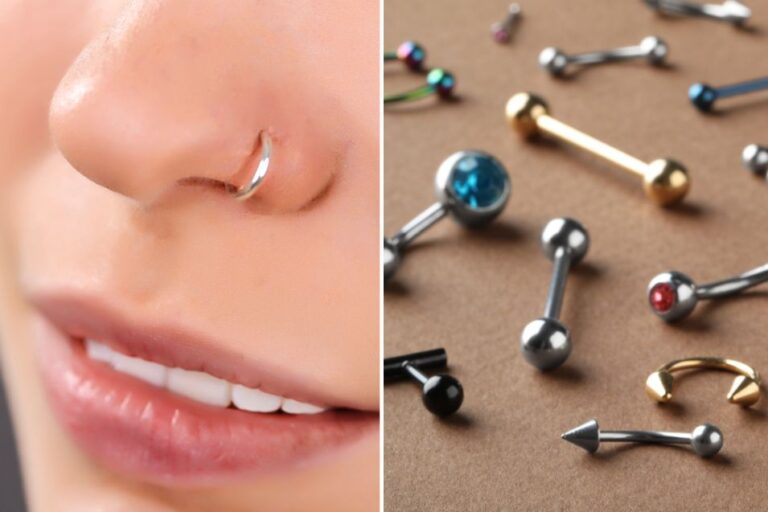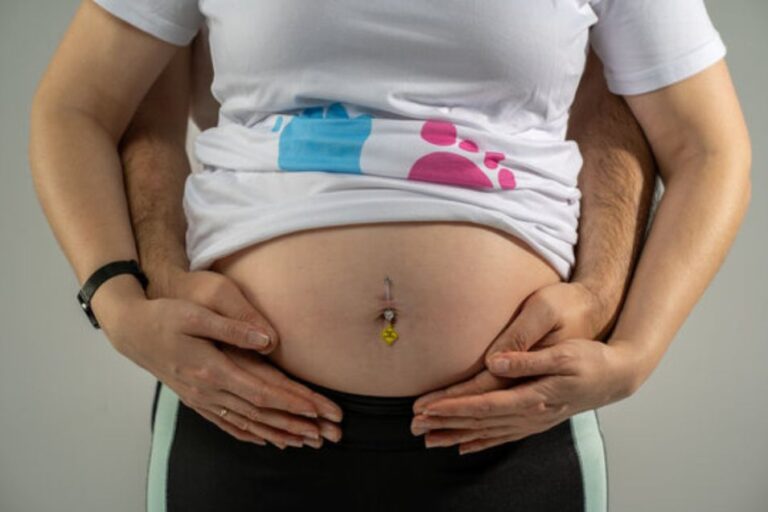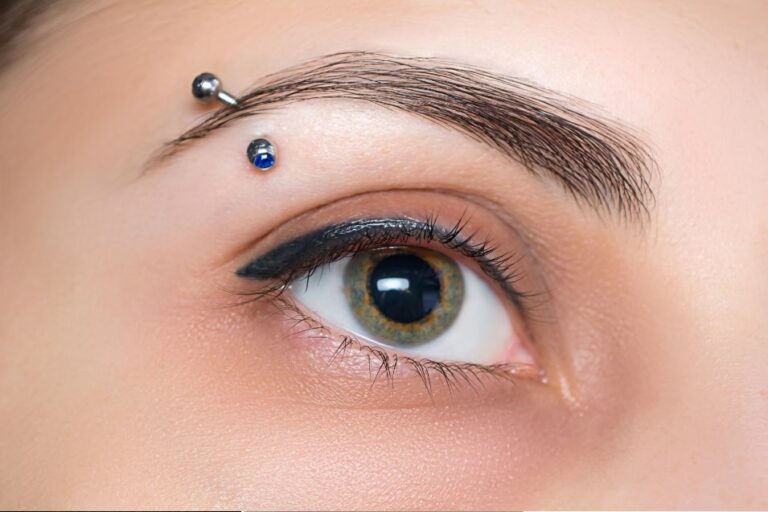The Ultimate Guide to Industrial Piercing: Process, Pain, Cost, and Healing Time
An industrial piercing is a unique type of ear piercing that connects two holes in the upper cartilage with a straight barbell. It looks stylish and edgy, but it requires proper care to heal well. In this guide, you will learn about the piercing process, how much pain to expect, the cost, and how long it takes to heal. Whether you are thinking about getting one or already have it, this guide will help you understand everything you need to know to keep your piercing healthy and looking great.
What is an Industrial Piercing?

An industrial piercing is a type of ear piercing that involves two separate holes connected by a single piece of jewelry. Usually, it is done on the upper part of the ear, through the cartilage. The jewelry used for this piercing is typically a straight barbell that runs diagonally across the ear, giving it a bold and stylish look.
This piercing stands out because of its unique placement and appearance. It has become popular among people who want a distinctive and edgy style. There are different jewelry options available, such as barbells with decorative ends or simple metal bars, allowing each person to choose a look that matches their personal style.
How Much Does an Industrial Piercing Cost?
The cost of an industrial piercing can vary depending on several factors. Usually, the price ranges from $40 to $100, but it might be higher or lower based on your location, the piercing studio, and the experience level of the piercer. Higher-quality studios or those in big cities may charge more.
Additionally, the type of jewelry you select can affect the overall price. Basic jewelry, like simple stainless steel barbells, tends to be cheaper, while premium materials such as titanium or jewelry with decorative designs will cost more. It’s best to visit or call local piercing studios beforehand to ask about exact prices and what’s included in the fee.
Do Industrial Piercings Hurt?
Yes, industrial piercings usually cause some pain because they pass through cartilage, which is harder than the soft skin of the earlobe. Most people describe the pain level of an industrial piercing as moderate to high, rating it around 5 to 7 out of 10. You might feel a sharp pinch or pressure during the piercing.
However, the pain usually lasts only a few moments while getting pierced, followed by some throbbing or soreness afterward. Everyone has different pain tolerance levels, so your experience might be slightly different. Choosing an experienced piercer can also help reduce discomfort, making the process quicker and smoother.
How Long Does an Industrial Piercing Take to Heal?
An industrial piercing typically takes between 6 to 12 months to fully heal. Since this piercing passes through cartilage in two places, it heals more slowly than piercings in softer areas like the earlobe. During the first few months, it may look healed on the outside, but the cartilage inside takes longer to completely recover.
It’s important to take extra care during the healing period to avoid complications. Keeping the area clean and not touching or twisting the jewelry unnecessarily can help speed up the healing process. Each person’s body heals differently, so it’s normal for some industrial piercings to take slightly less or more time to fully heal.
What Gauge is an Industrial Piercing?
An industrial piercing typically uses a 14-gauge barbell, which is about 1.6 millimeters thick. This gauge is standard because it’s sturdy enough to support the piercing and helps reduce the risk of tearing or irritation.
However, some piercers might use a slightly thicker or thinner gauge depending on your ear anatomy or personal preference. It’s important to discuss this with your piercer beforehand. Using the correct gauge helps ensure the piercing heals properly and comfortably.
How to Pierce Industrial?
Piercing an industrial involves making two separate holes in the upper cartilage of the ear, which are then connected by a straight barbell. This procedure should only be done by a professional piercer using sterile equipment to prevent infections and complications. The piercer will first clean the area and mark the entry and exit points to ensure proper alignment.
A hollow needle is then used to create the first hole, followed by the second hole, both in a straight line. Once both holes are made, the piercer will insert a barbell and secure it with threaded balls on each end. Since this is a complex piercing, it’s important to choose an experienced piercer to ensure correct placement and minimize pain or healing issues.
Industrial Piercing Size Chart
| Gauge Size (G) | Gauge Thickness (mm) | Barbell Length (mm) | Common Use | Material Options |
| 16G | 1.2mm | 30mm – 40mm | Used for thinner cartilage or smaller ear anatomy | Surgical Steel, Titanium, Gold-plated, Bioplast |
| 14G | 1.6mm | 32mm – 38mm | Standard size for most industrial piercings | Titanium, Surgical Steel, Acrylic, Gold |
| 12G | 2.0mm | 35mm – 40mm | Used for stretched piercings or larger anatomy | Surgical Steel, Titanium, Glass, Wood |
| 10G | 2.4mm | 38mm – 42mm | Rare, for customized larger piercings | Titanium, Stainless Steel, Glass |
When Can You Change Your Industrial Piercing?
You can change your industrial piercing only after it is fully healed. Since this piercing goes through cartilage in two places, healing takes longer than other piercings. If there is still pain, swelling, or discharge, it means the piercing is not ready for a jewelry change.
Before switching jewelry, make sure the area feels normal, with no tenderness or redness. If you’re unsure, it’s best to ask a professional piercer. Changing the jewelry too soon can cause irritation or slow down healing, so always wait until your piercing is completely healed.
How to Take Out an Industrial Piercing?
To safely remove an industrial piercing, first wash your hands thoroughly to avoid infection. Next, gently hold the barbell steady with one hand and carefully unscrew one of the ball ends with your other hand. Once you’ve unscrewed the ball completely, gently slide the barbell out through the piercing holes, moving slowly to avoid irritation.
If you’re finding it difficult to unscrew the ball ends, you can use rubber gloves or a clean tissue to improve your grip. Remember, always remove the jewelry slowly and gently. If your piercing is relatively new or you’re unsure about doing it yourself, it’s best to visit a professional piercer who can safely remove it for you.
How to Clean Industrial Bar Piercing?
To clean your industrial bar piercing, first wash your hands well with soap and water. Then, mix a solution of warm water and sea salt (about ¼ teaspoon of sea salt in a cup of water). Soak a clean cotton pad or gauze in this solution and gently apply it around the piercing area, removing any crust or buildup.
You should clean the piercing twice a day, making sure to gently move the bar slightly so the cleaning solution reaches the pierced holes. Avoid using harsh products like alcohol or hydrogen peroxide, as these can irritate the skin. Always dry the area gently with a clean towel or tissue afterward. Keeping your industrial piercing clean helps prevent infections and ensures it heals properly.
How to Take Care of Industrial Piercing?
Taking care of an industrial piercing is important to ensure proper healing and prevent infections. Clean the piercing twice a day using a saline solution (a mix of warm water and sea salt) or a piercing aftercare spray. Gently soak a cotton pad in the solution and press it against the piercing for a few minutes. Avoid touching or twisting the jewelry unnecessarily, as this can cause irritation and slow down healing.
It’s also important to avoid sleeping on the piercing, as pressure can lead to swelling and discomfort. Keep hair, hats, and headphones away from the area to reduce the risk of bacteria getting into the piercing. Always wash your hands before cleaning or touching the piercing.
Frequently Asked Questions About Industrial Piercings
Keloids are raised scars that can form around an industrial piercing. To reduce them, apply silicone gel or use over-the-counter scar treatments. If the keloid persists, consult a dermatologist for options like steroid injections or laser treatment.
Industrial piercing bumps can be caused by irritation, infection, or trapped fluid. Clean the area with a saline solution twice a day and avoid touching or twisting the jewelry. If the bump doesn’t improve, try using chamomile tea compresses or see a piercer for advice.
Mild itching is normal during the healing process, as the skin repairs itself. However, excessive itching may be due to irritation, an allergic reaction to the jewelry, or an infection. If the itching is severe or comes with redness and swelling, switch to high-quality jewelry and keep the area clean.
A vertical industrial piercing is a variation where the barbell runs vertically through the ear’s cartilage instead of diagonally. It typically connects two holes aligned in a straight up-and-down position. This style is less common but offers a unique look.
The right anatomy for an industrial piercing includes a well-defined, slightly raised ridge of cartilage on the upper ear. If your ear lacks this structure or has a flat shape, an industrial piercing may not sit properly and could cause discomfort or migration. A professional piercer can assess whether your ear is suitable.





